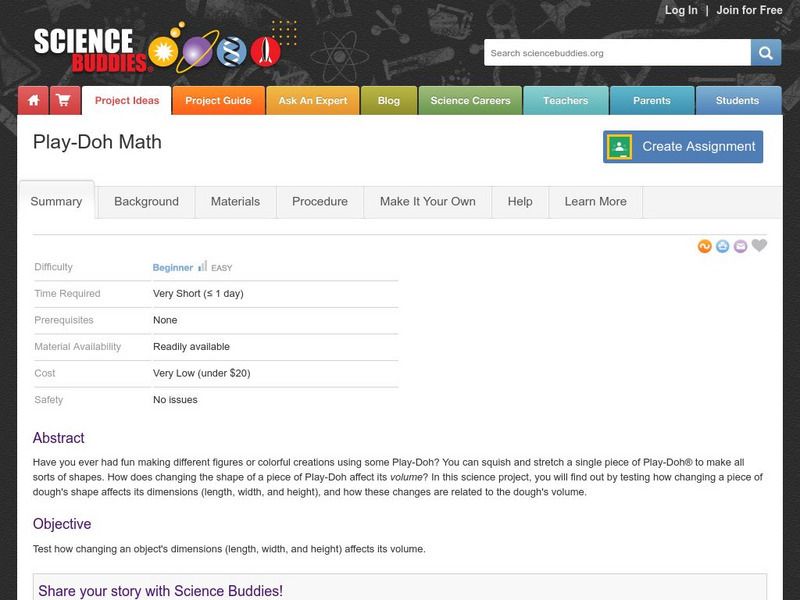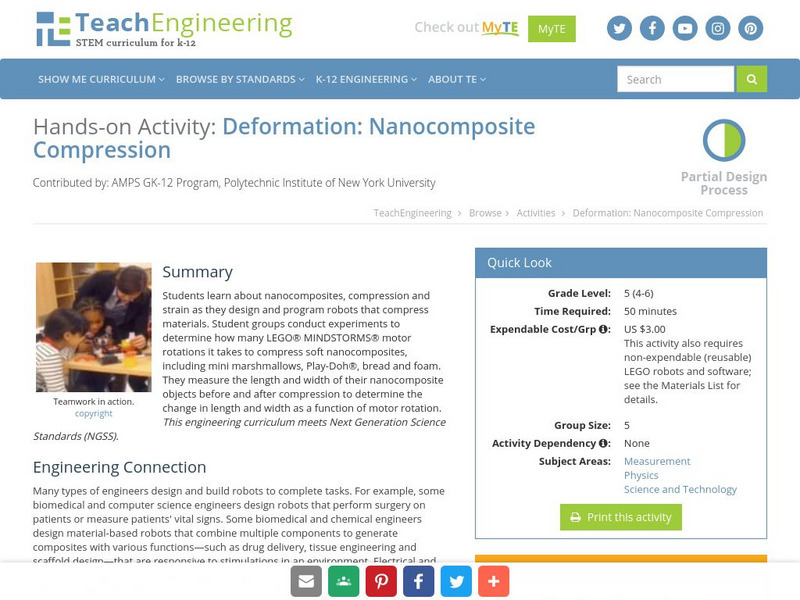Curated OER
Baseball Geometry
Middle schoolers apply various methods for finding the volume and surface area of sphere. They compare and contrast results among these mathematical methods. They work in cooperative groups to discuss their results with one another.
Curated OER
Gene Switches- A Model
Students explore genetic variation within a population. In this genetic adaptation lesson plan, students investigate the reasons contributing to genetic adaptation. Students collaborate and analyze DNA models. Multiple resources are...
Curated OER
The Human Brain
Students identify parts of the human brain. In this biology lesson, students watch a video about the human brain. Students use different colors of clay to construct and label the three parts of the brain.
Lauren Kitchin
Singing in the Classroom
Those new to the Kodály Method of music instruction, as well as experienced educations, will find everything they need in a resource designed to launch a five-week vocal music program. Packed with warm ups, games, activities, and...
Curated OER
Mixing Primary and Secondary Colors
Students create their own color wheel by mixing colors of Playdoh. Each child names the primary and secondary colors.
Curated OER
A Serving By Any Other Name
Students examine the information given on food labels. They also discover what a serving size is and determine how much they eat over the suggested serving. They also calculate the number of calories are in different foods.
Curated OER
Structural Geology Laboratory
Students explore modeling of geologic structures in experiments. They study how compressive and tensile forces produce these structures. The compression makes the flatlying strata shorter and tension make the strata longer.
Curated OER
The Global Grapefruit - Maps vs Globes
Students tell how maps differ from globes, state some characteristics of 3 different types of map projections, and realize that distortions are inherent in various systems of map projections.
Curated OER
Greece: The Landscape
Students work in small groups to create a topographic map of Greece. They must include labeled line drawings of bordering countries and bodies of water. Students use salt and flour clay to make Greece three dimensional, showing the many...
Curated OER
The Landscape of Poland
Students recognize and re-create the political boundaries and physical features of the nation of Poland. They create three dimensional topographic maps of Poland. In addition, they compose two journal entries written in two different...
Curated OER
The Landscape
Students recognize and recreate the political boundaries and physical features of the nation of Slovakia. They create topographic maps of Slovakia. The maps should include labeled line drawings of bordering countries. Slovakia should be...
Curated OER
Industrial Processes of Polymers: How toys Are Made
Young scholars explore how technology and science have created the plastics that make toys. In this industrial processes lesson students work on their own injected molded product and a blow molded product.
Curated OER
Lungs: The Breathing Machine
Students create a model of the lungs and diaphragm. In this breathing lesson, students create a model out of a plastic bottle and balloons. They see how the diaphragm helps to fill the lungs with air.
Curated OER
Create your own thermometer
Students participate in an activity where they build a calibrated thermometer. In this thermometer lesson students complete this activity and take notes.
Curated OER
Cute and Easy Christmas Tree Ornaments (Elementary, Art)
Learners create Christmas tree ornaments.
Curated OER
United Kingdom
Middle schoolers investigate the geographical features of the United Kingdom. They create a clay, playdoh, or salt and flour map of the region. The maps should be labeled with landmarks and bodies of water. They can also draw maps on...
Curated OER
Food Pyramid
Second graders are introduced to the food groups on the food pyramid. Individually, they draw pictures of their favorite foods and identify which food group it belongs. To end the instructional activity, they discuss the importance of...
Curated OER
Balloon Lungs
Students study the function of lungs. In this lung function lesson, students complete an experiment using balloons to study the way lungs work. Students study a diagram of their lungs and make a hypothesis for their lung capacity...
Science Buddies
Science Buddies: Play Doh Math
One piece of Play-Doh can make many different shapes. Even though you can change the shape by squishing or stretching the Play-Doh, it is still the same size unless you add or take away some of the dough. Try this experiment to test how...
A&E Television
History.com: The Surprising Origins of 7 Classic Toys
Many childhood memories include hours spent molding Play-Doh, or watching a Slinky glide down the stairs, or marveling at the transfer of a newspaper comic to a simple wad of Silly Putty. But those famous novelty toys didn't start out as...
TeachEngineering
Teach Engineering: Deformation: Nanocomposite Compression
Students learn about nanocomposites, compression and strain as they design and program robots that compress materials. Student groups conduct experiments to determine how many LEGO MINDSTORMS NXT motor rotations it takes to compress soft...
Alabama Learning Exchange
Alex: Learning the Three Layers
This lesson will help students visualize the Earth's crust (lithosphere), mantle, and core. The students will work in groups to research and design a model of the Earth's layers. Some of the types of models include: computer, fruits such...
Other popular searches
- Play Doh Enzymes
- Fault Lines Play Doh
- Making Play Doh
- Play Doh Map
- Play Doh Math
- July 4th Play Doh
- Solar System Play Doh
- Play Doh Learning Center
- Creating Play Doh
- Amking Play Doh
- Color Play Doh
- Greece Map Play Doh























